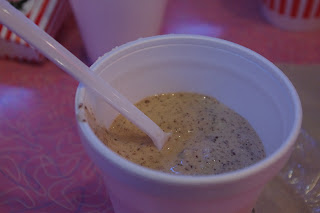Part III : PERSONAL
When Pollan decides to created a meal that is self-made, meaning a meal that he has "hunted, gathered, and grown" (p.277) entirely on his own, and that includes plant, animal, and even mineral ( at least he hopes so), I was skeptical.
Pollan's quest looks rather unusual since he points out that the hunter-gatherer food chain no longer represents a "viable" way for us to eat. There are simply too many humans and too little land.
Creating a meal is something that we can not learn from supermarkets or even farms according the Pollan. Indeed, we learn previously that we have no idea were the food we eat comes from. We are eating what the industry gives us to eat.
Pollan is a regular human, just like me and you. He does not know how to create a meal from scratch, and most of all, he never killed an animal.
First, to be able to hunt, you have to have a hunting license, which is a looooong process. It took him a couple of month to get his license. Here is my exact thought : " American paradox again. You can buy guns in store, but you have to take a test and wait months to get a hunting license." It wasn't that far-fetched. Pollan acknowledges this in his book.
This was not the last time that I agreed with Pollan. I found myself nodding in agreement when he writes in chapter 16:
"The French eat all sorts of supposedly unhealthy foods, but they do it according to a strict ans stable set of rules : They eat small portions and don't go back for seconds; they don't snack; they seldom eat alone; and communal meals are long, leisurely affairs. In other words, the French culture of food successfully negotiates the omnivore's dilemma, allowing the French to enjoy their meals without ruining their health." (p.301)
Folks, apparently this is common knowledge EVEN in the US. So... why on earth do you still have snacks, super-sized portions and, above all, why do you eat in a CAR ?????
Pollan explains that the American have not been around long enough to develop a strong food culture. Hence the fact that there is currently a "melting pot" in the US. America is lacking a unifying theme.
Pollan is being polite. I will not write my thought at this precise moment, but let me tell you that I am really irritated. I'll just carry on.
This is why Pollan thinks that the Americans are uniquely susceptible to the "national eating disorder" he mentioned earlier on the book. There is no consensus in the US about " what and how and where and when to eat". But this is crucial, there should be one, right?
Chapter 18 describes Pollan and the hunting part. He missed the pig once. After finally succeeding in killing the pig, Pollan is happy unlike what he was expecting. There is no guilt at first.
After a while, the sense of shame nonetheless appears.
No matter what, this was brave. I am not sure I would be able to kill a pig.
Once Pollan has all he needs to create his "perfect meal" ( even fungus) , it is time to cook.
The author invites to dinner only the people who helped him. (10 people) He makes a list of rules (see page 392 in the book) and ends up spending the entire day( litteraly) in the kitchen.
The book closes with the meal, Pollan recalls the McDonald's lunch with his wife and child in the car, which was in total opposition to this final meal.
As a conclusion, I quote the author who says about his final meal: " This is not the way I want to eat every day. I like to be able to open a can of stock and I like to talk about politics, or the movies, at the dinner table sometimes instead of food. But imagine for a moment if we once again knew, strictly as a matter of course; these few unremarkable things: What is it we're eating. Where it came from. How it found its way to our table. And what, in a true accounting, it really cost. We could then talk about some other things at dinner. For we would no longer need any reminding that however we choose to feed ourselves, we eat by the grace nature, not industry, and what we're eating is never anything more or less than the body of the world." (p.411)
This was not answering the idea of a perfect meal. Nothing is perfect any way, but this ending was close.








